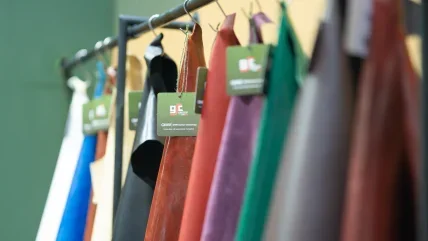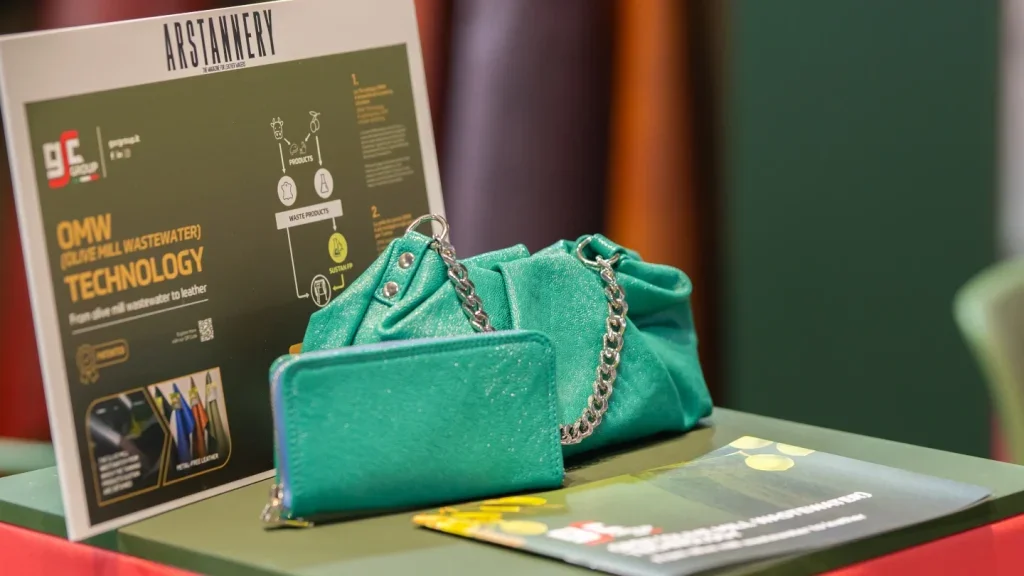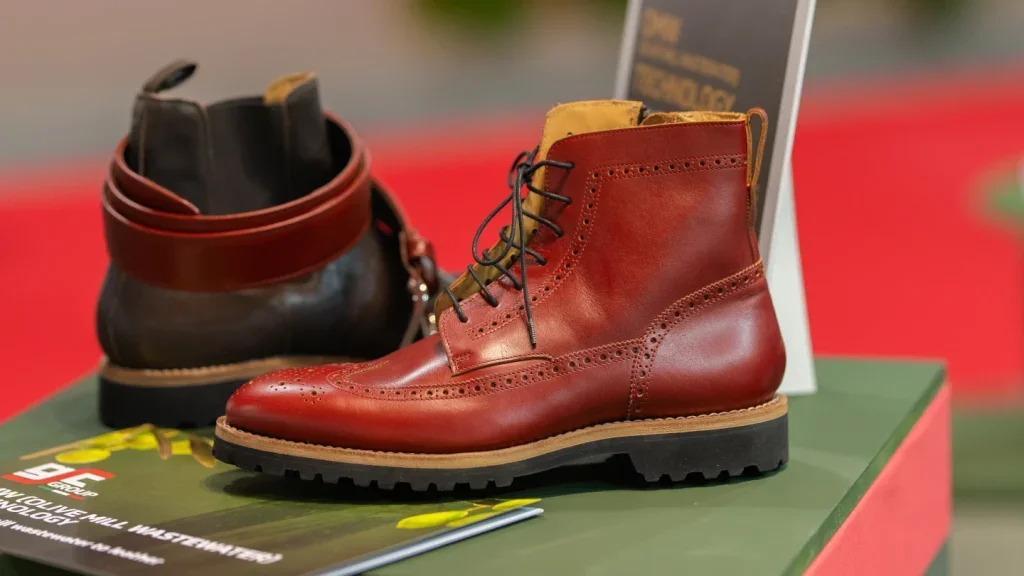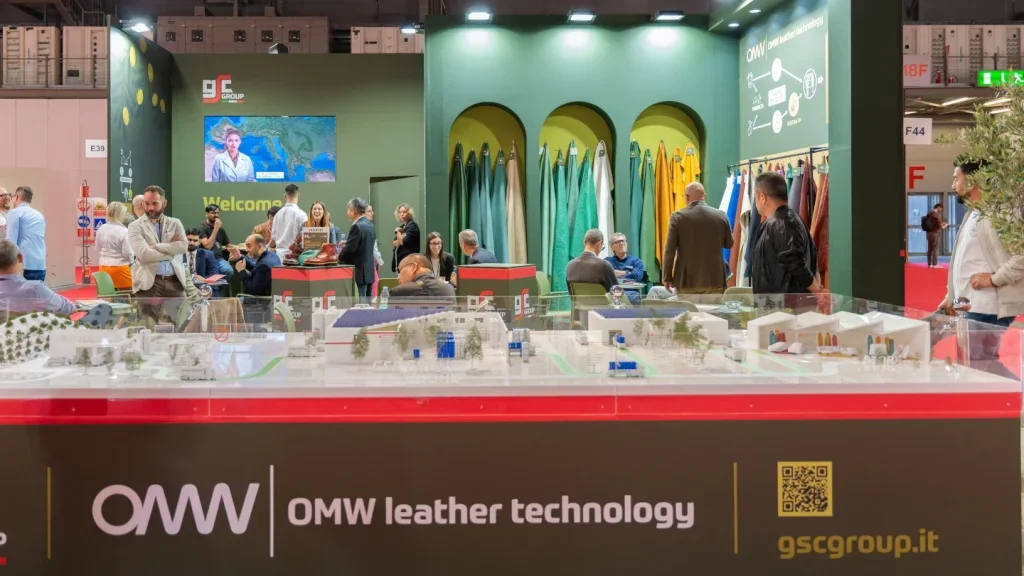
The OMW Leather Technology, patented internationally and protected by a registered trademark, is based on the use of olive mill wastewater (OMW), a waste product generated during the production of olive oil. These waste-waters come from a series of mechanical and physical operations carried out in the olive mill, culminating in the centrifugation process that separates the olive oil from the paste, resulting in the liquid residue (Olive oil Mill Wastewater OMW). It eventually contains wash water, liquid recovered from residual oil, and juices derived from the pulp and pits of the olives. In 2023, Italy produced about 328 thousand tonnes of olive oil, accompanied by around 4 million tonnes of OMW, a considerable volume that has so far seen limited recycling.

New Life for Olive Mill Wastewater
Olive oil industry wastewater, although free from pathogens and heavy metals, contains high concentrations of soluble organic compounds, making it highly polluting. Their antifermantative, antibacterial, and antifungal properties, if not properly treated, can harm the environment by contaminating water resources and reducing soil fertility. Typically, these wastewaters are treated in wastewater treatment plants, but GSC Group has found a way to valorise this material, transforming it into a resource for tanning. The OMW used by GSC Group’s production facilities must meet strict quality criteria before being used. It is essential to characterise the solid content, viscosity, acidity, and tanning properties, with particular attention to the concentration of polyphenols, which is a crucial parameter for effective use.
Polyphenols play a crucial role in tanning due to their micro-interactions with dermal fibres. To ensure consistent performance, their concentration must fall within a specific range defined by research and development. To guarantee the raw material complies with the required standards, GSC Group technicians constantly monitor the quality of the OMW throughout the transformation process. Through accurate concentration, stabilisation, and titration checks, they ensure consistent and reproducible performance, transforming the raw material into a reliable product for the leather industry.

Key technical parameters of the process include:
- pH of treated OMW: 4.5–5.5, ideal for polyphenol stabilisation.
- Viscosity of the tanning solutions obtained: 300–500 cP, optimal for penetration into leather tissues.
- Polyphenol concentration: up to 25–30%, ensuring highly efficient tanning.
The OMW product portfolio primarily includes SUSTAN FP, which acts as a polymer with phenolic tanning properties derived from the recovery of waste from the olive oil industry, and SUSTAN PRE, based on synthetic tannins from dihydroxyphenylsulfone (DDS), which provides a crosslinking effect. It also includes greases, resins, and tailor-made synthetic tannins.
The use of natural and renewable resources gives OMW products a high carbon content. The entire OMW range is formulated with non-hazardous chemicals and is completely free from harmful components. The products do not contain formaldehyde and have residues well below safety thresholds. Additionally, this technology fits within metal-free tanning processes. All these characteristics are vital for obtaining high-quality leather that is fully compliant with the strictest environmental regulations.

Practical Benefits for Tanneries: Versatility, Performance, Sustainability, Made in Italy
To date, OMW technology has already been adopted by numerous tanneries for the production of leather destined for various sectors, ensuring high standards of resistance, durability, and aesthetic quality. This technology is applicable in both tanning and retanning processes. It is compatible with industrial standards and can be used for retanning mineral leathers, such as chrome wet blue and wet white retanning. Furthermore, it can also be used in vegetable tanning, as both rely on natural components as tanning agents. A fundamental element of this innovation is the interaction between natural compounds and synthetic tannins, which gives the leather superior resistance and makes it suitable for a wide range of applications, including fashion, furniture, and automotive. During the production process, waste generation involves both solid and liquid waste, such as leather shavings, tanning and retanning baths, tanning liquors, and sludges. OMW technology offers a completely organic solution, eliminating the presence of heavy metals or harmful substances in the solid waste, making complete recovery possible through thermal treatments.
Moreover, the biodegradability and reduction of the ecological footprint of the process offer tanneries the opportunity to respond effectively to the growing demand for eco-sustainable products from consumers and global regulations. Leather treated with this technology has a relative biodegradability of 93.4%, according to the UNI EN ISO 20136:2020 method. This value is significantly higher than leather treated with glutaraldehyde, which has a relative biodegradability of 84.7%.
An important point to highlight is that the production of OMW technology is entirely Italian. The olive mill wastewater comes from mills located in Tuscany and Puglia, while the production of tanning agents is entirely carried out in Italy. This gives the project a genuine “Made in Italy” stamp, synonymous with quality and innovation.
In conclusion, OMW Leather Technology is not only a new technical solution but represents a more responsible industrial process, capable of responding to the needs of a constantly evolving market and providing companies with a competitive advantage. By combining innovation and environmental respect without compromising product quality, this technology stands out as a forward-looking choice for the future of the leather industry.





